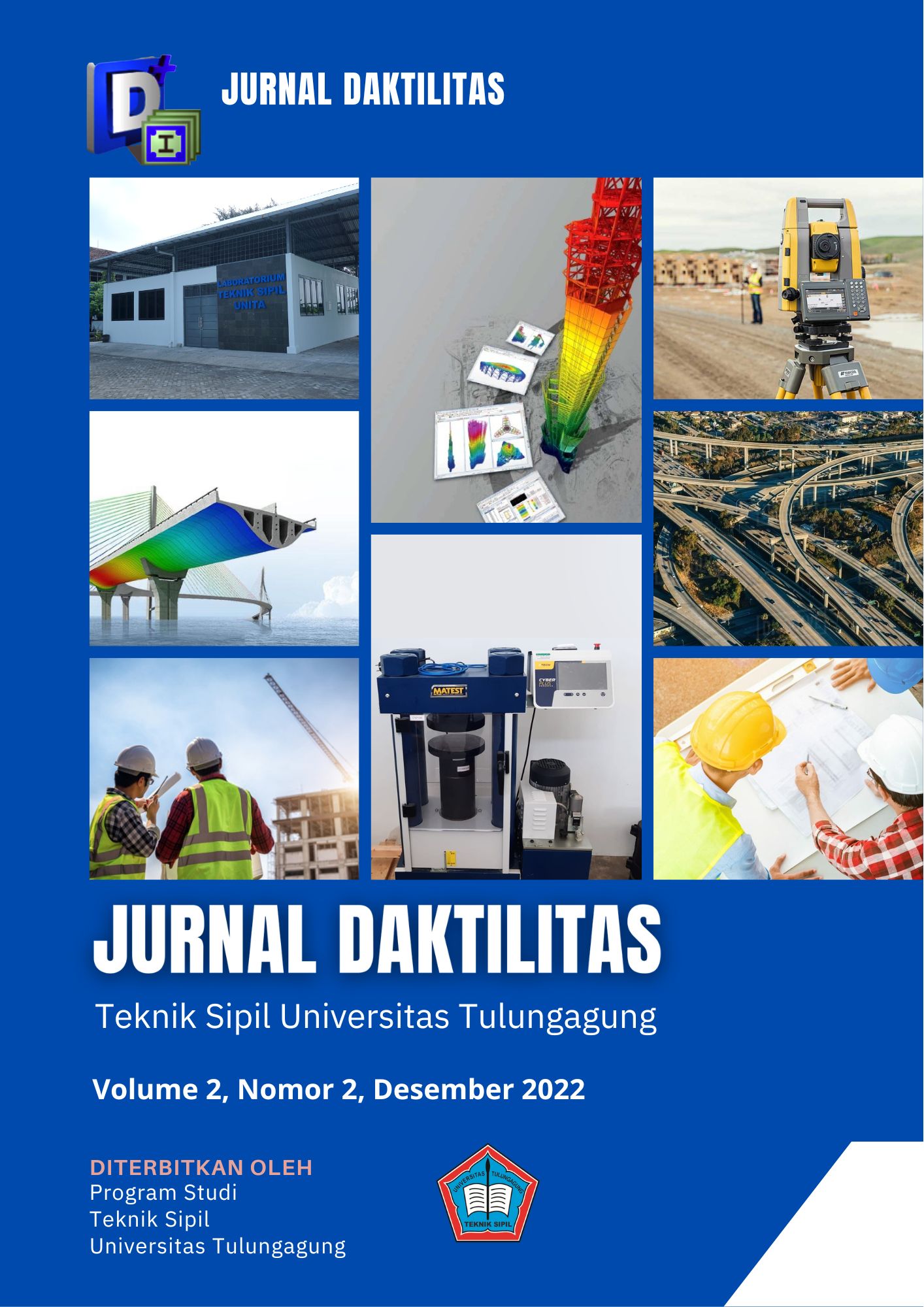PENELITIAN PASIR DARI SUNGAI BRANTAS DESA PADANGAN KECAMATAN NGANTRU KABUPATEN TULUNGAGUNG
DOI:
https://doi.org/10.36563/daktilitas.v2i2.704Keywords:
sungai, vulkanik, agregatAbstract
Abstrac
The objectives of the study are: (1) Determining the division of grains (gradations) of the aggregate, (2) Determining the amount of material in the aggregate that passes the sieve No. 200 by washing, (3) Checking the weight of the contents of the fine aggregate as well as the weight of the contents of the mixture, (4) Determining the moisture content contained in the aggregate by drying, (5) determining the specific gravity of bulk (bulk), dry specific gravity of the saturated surface (SSD), The apparent specific gravity of the coarse/fine aggregate and the absorption rate of the coarse/fine aggregate against water, (6) testing aggregate wear with a los angeles abrasion machine.
This study uses the following methods: (1) Analysis of fine and coarse aggregate sieves, (2) Inspection of the amount of material in the aggregate that passes in sieve No. 200(0.075), (3) Inspection of aggregate content weight, (4) Moisture content of aggregates, (5) Specific gravity and absorption of coarse aggregates, (6) Specific gravity and absorption of fine aggregates, (7) Aggregate wear with los angeles abrasion machines.
Based on the results of the study, it can be concluded that from the calculation results for the Aggregate Sieve Analysis Test of test objects I, II, III, an average Grain Fine Modulus of 3.0 was obtained, then it was among the Fine Modulus of Zone 2 Fine Aggregate Grains, namely 2.61-3.00 (Medium Sand). The average sludge content of fine aggregates was 2.80%. So it can be concluded that the sand can be directly used in the concrete mixture without having to be washed first, because the maximum sludge content required for fine aggregate is 5%. In this experiment, the moisture content obtained has met the specification standards, namely the average for fine aggregates of 1.910% while for the average coarse aggregate of 2.600%. And the specification standard of moisture content in ASTM C 555-97 is 0.5% - 2.0%.
Keywords: river,volcanic,aggregate
Abstrak
Tujuan penelitian adalah : (1) Menentukan pembagian butir (gradasi) agregat, (2) Menentukan jumlah bahan dalam agregat yang lolos saringan No. 200 dengan cara pencucian, (3) Memeriksa berat isi agregat halus serta berat isi campuran, (4) Menentukan kadar air yang terdapat pada agregat dengan cara pengeringan, (5) menentukan berat jenis curah (bulk), berat jenis kering permukaan jenuh (SSD), Berat jenis semu (apparent) dari agregat kasar/halus dan tingkat penyerapan agregat kasar/halus terhadap air, (6) menguji keausan agregat dengan mesin abrasi los angeles.
Penelitian ini menggunakan metode : (1) Analisa saringan agregat halus dan kasar, (2) Pemeriksaan jumlah bahan dalam agregat yang lolos dalam saringan No. 200(0.075), (3) Pemeriksaan berat isi agregat, (4) Kadar air agregat, (5) Berat jenis dan penyerapan agregat kasar, (6) Berat jenis dan penyerapan agregat halus, (7) Keausan agregat dengan mesin abrasi los angeles.
Berdasarkan hasil penelitian dapat disimpulkan bahwa Dari hasil perhitungan untuk Pengujian Analisa Saringan Agregat benda uji I,II,III, diperoleh Modulus Halus Butir rata-rata sebesar 3,0, Maka berada di antara Modulus Halus Butir Agregat Halus Zona 2 yaitu 2,61-3,00 (Pasir Sedang). Kadar lumpur rata-rata agregat halus sebesar 2,80 %. Sehingga dapat disimpulkan bahwa pasir tersebut dapat langsung digunakan dalam campuran beton tanpa harus dicuci terlebih dahulu, karena kadar lumpur maksimum yang disyaratkan untuk agregat halus adalah sebesar 5 %. Dalam percobaan ini kadar air yang diperoleh sudah memenuhi standar spesifikasi yakni rata-rata untuk agregat halus sebesar 1,910 % sedangkan untuk rata-rata agregat kasar sebesar 2,600 %. Dan standar spesifikasi kadar air dalam ASTM C 555-97 adalah 0,5% - 2,0%.
Kata kunci: sungai, vulkanik, agregat
Downloads
Downloads
Published
Issue
Section
License
Authors who publish with this journal agree to the following terms:
- Copyright on any article is retained by the author(s).
- The author grants the journal, right of first publication with the work simultaneously licensed under a Creative Commons Attribution License that allows others to share the work with an acknowledgment of the work’s authorship and initial publication in this journal.
- Authors are able to enter into separate, additional contractual arrangements for the non-exclusive distribution of the journal’s published version of the work (e.g., post it to an institutional repository or publish it in a book), with an acknowledgment of its initial publication in this journal.
- Authors are permitted and encouraged to post their work online (e.g., in institutional repositories or on their website) prior to and during the submission process, as it can lead to productive exchanges, as well as earlier and greater citation of published work.
- The article and any associated published material is distributed under the Creative Commons Attribution-ShareAlike 4.0 International License
Deprecated: json_decode(): Passing null to parameter #1 ($json) of type string is deprecated in /home/journal.unita.ac.id/public_html/plugins/generic/citations/CitationsPlugin.php on line 68





